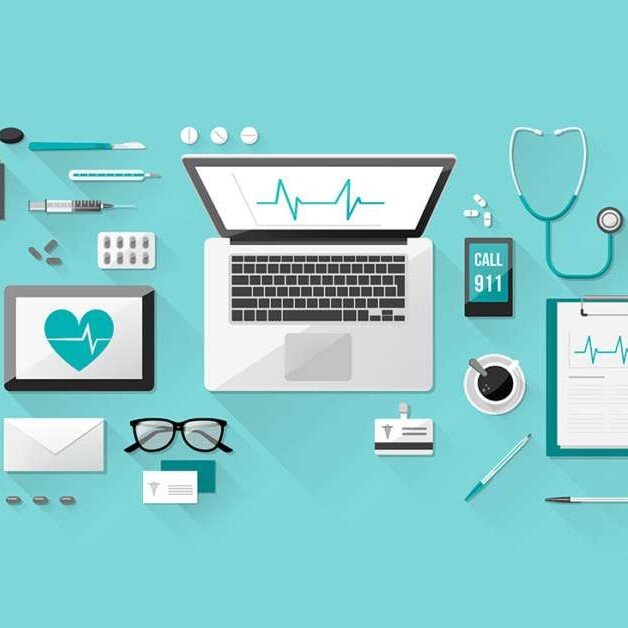1. Medical records
Health information technologies are used in the design of electronic health records for patients that give accurate and complete information about the patient’s health.
These record systems help health providers better manage patients by providing timely and secure access to their health data at any point in time, whether during a routine visit or in a medical emergency.
These electronic health records ensure the accuracy of health data storage and retrieval.
They also provide a means to securely share patient data with other authorized health professionals or healthcare providers when necessary while ensuring the confidentiality of both the patient and the health professionals.
This facilitates a good working relationship among patients, their caregivers, health professionals, and healthcare organizations.
2. Patient follow-up and mobile health
Patient input is needed in the management of their disease, especially as regards non-communicable diseases that are managed largely by lifestyle changes.
Health information technologies introduce several ways to engage these patients to take control of their health; an example is the text message, email, and/or mobile notification reminder system, including appointment reminders, medication reminders, etc., that guide patients to take needed action as regards their health.
Follow-up reminders help patients adhere to instructions received from physicians during their visits to their physicians.
3. Telehealth and telemedicine
Remote care is made possible with health information technology.
Compared with conventional phone or video calls that involve personal, sometimes non-sensitive data, telehealth deals with sensitive patient data when communicating with physicians; hence, it must be protected and secured from tampering.
Telehealth systems have incorporated more advanced security measures to boost access to remote care around the world and protect users on both ends of communication.
Telehealth comes with benefits including boosting access to general physicians and specialists, convenience in accessing care, reducing hospital wait time, better patient follow-up, etc.
4. Data privacy and security
All internet networks are cyberattack targets, but healthcare providers are desirable targets for cybercriminals.
Health information systems make use of advanced security technologies, making them nearly impossible to hack, in the management and protection of health data, especially with the use of data encryption in transit when they are being shared.
Some of these systems have inbuilt designs to enforce routine data backup, data transfer only on secure channels, use of multi-factor authentication to log in, etc.
5. Operational efficiency and cost saving
Organizational processes in health facilities are being aided by the use of information management systems.
Health information technologies introduce improved efficiency in the running of these facilities as well as improve their productivity.
Clinically, they improve healthcare work processes and clinic performance by smoothing the process of appointment bookings, patient management plans, discharge notes, patient counseling, etc.
All these culminate in an efficient and, hence, cost-effective healthcare ecosystem, as these technologies help identify and eliminate cost excesses and duplicate efforts.
6. Reduced repeated tests
Health professionals don’t have a perfect memory of when prior patient tests were done or always know if they are still relevant.
Information systems can be programmed to only request a recent test after the prior test result is no longer relevant.
Requesting a repeat test when a prior one is still relevant would be flagged and denied, forcing health professionals to review the prior but still relevant test results.
These systems also put test results in one place for each patient; hence, health professionals can access and review prior test results without ordering a repeat.
7. Health data analysis
Health data is a goldmine in sectors of healthcare, including hospital administration, business decision-making, medical research, drug development, disease surveillance, etc.
Health information technologies help design health systems that process and analyze health data for improved business decision-making in health facilities and businesses, helping them stay competitive in the business world.
These systems also guide decision-making in health policies in government parastatals.
Data reveals disease trends and helps guide preventive strategies for managing them.
Also, they review patient data to find better management plans for improved healthcare outcomes.
8. Drug development and prescription management
Insight into pharmaceutical research and drug development is being aided by the input of health information technologies.
These technologies help process data from drug trials towards the advancement of drug development in healthcare.
As regards prescription management, they save patients time as physicians can send an e-prescription directly to a pharmacy.
They also enhance the creditable prescription of drugs, avoiding medication errors by eliminating illegible handwriting on prescriptions.
Electronic prescriptions prevent duplications in prescriptions and alert physicians to common drug interactions or known patient allergic reactions to medications.
9. Disease surveillance
The use of information technology in healthcare helps health organizations analyze disease trends in the population to identify and appropriately tag diseases as endemic, epidemic, or pandemic.
They further assist with organizing efficient preventive strategies, e.g., contact tracing, to curtail these diseases as well as control or cure them.
These technologies are being used in the management of chronic non-communicable diseases as well; they can identify risk factors for these diseases in the population, including hypertension, diabetes mellitus, etc., towards organizing health promotion campaigns in the community.
10. Interoperability
Information technology allows the accurate and detailed exchange and communication of information between patients and healthcare providers.
It has also been a major supporter of ever-evolving health information technology.
Obisesan Damola
Damola is a medical doctor who has worked in the Nigerian healthcare industry for a little over 3 years in a number of primary, secondary, and tertiary hospitals. He is interested in and writes about how technology is helping to shape the healthcare industry. He graduated from the College of Medicine, University of Ibadan, the foremost medical training institution in Nigeria.



